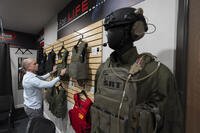Army Gen. Gus Perna has a vision of future conflicts in which soldiers will return to doing their own supply and maintenance rather than relying on contractors.
"My view is there won't be contractors on the battlefield at least initially, for sure," Perna, commander of U.S. Army Materiel Command (AMC), said Wednesday at a Defense Writers Group breakfast.
"Over basically the last 15 years, supply and maintenance transactions were done by contractors as we were in Afghanistan and Iraq because we were maintaining a force cap level -- only so many soldiers were allowed over there," he said.
The limited numbers of soldiers on Forward Operating Bases, or FOBs, were focused on the enemy, and "we wanted to make sure that the soldiers in those locations were executing their most important mission," Perna said.
Consequently, AMC brought in "contractors to do maintenance and supply on those FOBs," he said.
As a result, the Army neglected its logistics components, Perna said.
"We needed to focus our efforts on fighting, but the skills of the soldiers, the warrant officers, the leaders on how to execute supply accountability, maintenance, and then their processes" went into atrophy, he said.
Essentially, "we stopped doing maintenance and supply," Perna said. "Our skills atrophied. If you're not doing it, if somebody's doing it for you, then natural atrophy occurs."
The loss of logistics skills was one of his major concerns two years ago, he said, adding, "We're getting better every day, and we're building back our core competence to do this."
Another major concern was the time it took to get equipment out of prepositioned stocks worldwide and into the hands of soldiers.
"We've significantly reduced the time it used to take to 96 hours" from when he gets the call to draw down gear from prepositioned stocks to when it's moving to the field, Perna said. He would not quantify how long it used to take, but said it was "significantly longer."
Much of AMC's focus is now on managing the logistics of the Army's transition from a force primarily concerned with counter-insurgency operations to one that will also deal with "decisive action" against more conventional enemies, Perna said.
He also described "atrophy" regarding the availability of spare parts and maintenance for heavy equipment such Abrams tanks and Bradley Fighting Vehicles, which are getting more frequent use in training cycles.
"So tanks, Bradleys, we're racking up miles on that equipment, and things break," Perna said. For spare parts, "we no longer have the breadth and the depth of that being maintained on the shelf, both in the motor pools and then all the way back to industry.
"Industry will keep on the shelf what they're going to sell," he said. "They don't keep things on the shelf that they're not selling."
With the increase in operations tempo, "We increased our requirements for spare parts for that equipment, and we are building a demand to demonstrate that, 'Yes, we need the repair parts at the motor pool and we need the repair parts at industry,' " Perna said. "And so that's coming along, and it's getting stronger every day."
He did not respond directly when asked if AMC is speeding supplies to meet current threats in South Korea and northern Africa.
"Different locations have different challenges, and we address them accordingly," Perna said. "I am building supplies for all the combatant commanders."










